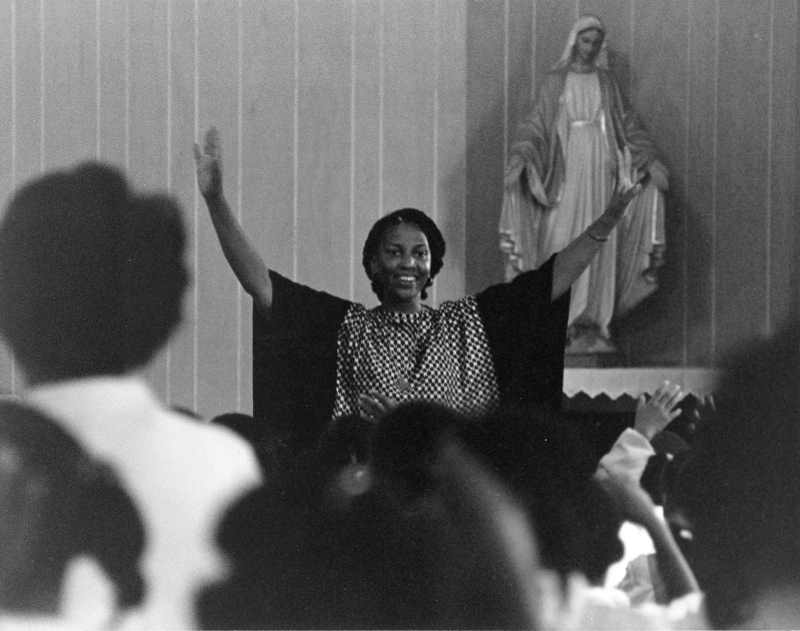“Musical Liberation”: Sr. Thea Bowman and Culturally Specific Catholic Worship

In addition to the weekly special edition blogs happening here, part of WOC’s Black History Month observation has been a series of posts over on our Instagram (@womensordination), each featuring a Black Catholic woman whose life we think should be more widely known—part of the canon, if you will. The series was inspired by a grim fact I saw when doing some research on Black Catholics: of the eleven saints canonized for their work in what is currently called the United States of America, none of them are Black. This is despite, of course, the profound influence and impact of the Black Catholic community in America, and so we were inspired to make a series highlighting Black women whom we would offer up as options for sainthood (just, you know, in case the Vatican were ever to ask us).
This series has required quite a bit of research on my end, reading up on the lives of women whose names I have, shamefully, only heard in recent years—even as recently as this year—despite my K-through-college Catholic education. This week, we feature Sister Thea Bowman, a Franciscan Sister of Perpetual Adoration who died in 1990. In 2018, she was named a Servant of God, the first of four major steps on the path towards possible canonization. As a history “person” (I majored in it in college and have just loved any and all history since I was a kid), I have found the stories of all the women we’ve featured and their locations in their social-historical moments to be fascinating, but I was unexpectedly moved—I actually teared up watching her give a speech, at one point—learning about the life and legacy of Sr. Thea, especially one piece of her work in particular. Sr. Thea was a major figure in the Black Catholic liturgical movement of the late 60s/70s/80s, one that was all about Black Catholics bringing their own unique histories, cultures, and spiritualities fully to Catholic worship. Sr. Thea had a specific interest even within that movement: sacred song. She asserted that there was a distinct form of Black Catholic worship, and that it was every bit as valid and Catholic as the more widespread white-centered, Roman-rite-style worship. Her efforts lead to the publication of Lead Me, Guide Me, the first specifically Black Catholic hymnal, published in 1987.
Something I was always taught in Catholic school was that Mass was the same around the world, and that that was something that made our faith unique. How wonderful, the thinking went, that you could go to Mass in New Zealand or Argentina or Germany or Vietnam and the flow of it would essentially be the same (though, of course, since Vatican II, the actual Mass is in the vernacular instead of Latin). On a college trip to Peru, we attended Mass at the church in the town square, knowing the ups and downs of the kneeling and moving as muscle memory in our bodies, though we had not mastered the spoken language. The same happened in a small church in Italy. Just last year (January, before everything changed), I was in Oaxaca, Mexico and slipped into the back of the town cathedral ten minutes into a Sunday evening mass, better understanding the language this time, soothed by the familiar motions and moved to share something essential—a form of worship, a religion—with the people who showed up there every week. There, I noticed what I hadn’t been taught: that there is, in fact, great global variety within the similarity of Mass. Mass felt different when I attended in different places around the world, even if much of it was the same.
But of the many far flung places I’ve been lucky to attend Mass (and I can’t wait to attend more, when we can travel again), the spot where I most noticeably and profoundly felt an elemental shift in worship style was just around the corner from my apartment at St. Augustine’s Parish at 14th and V NW in Washington, DC. When I first moved to DC, I went to St. Augustine’s simply because it was the closest parish to me and I was too lazy to go far. I had no clue the richness I was walking into: a church built in 1876 to serve a congregation that had been worshipping together in some capacity since the 1850s, when formerly enslaved Black folks were forced to worship in a segregated basement service at a nearby church. St. Augustine’s is considered by many to be “the Mother Church of Black Catholics,” and it was the first non-majority white Mass I’d ever been to in the United States. And you could feel it, this difference within the sameness of the worship: a different cadence to the priest’s homily, different musical choices. It was the first Mass I’d ever been to where the rafters were filled with the sounds of a full gospel choir. When Pope Francis visited the United States in 2015, the St. Augustine Gospel Choir performed for him and President Obama:
It sounds so silly now, looking back, how ignorant and uneducated I was—it’s shameful that I was surprised by it. But I’m writing about it here because I imagine a largely-white worship experience is common for many white Catholics in a church as segregated as ours, and I want to lift up that such a distinct form of worship would likely not exist if it were not for the work of people like Sister Thea Bowman who fought for it.

The history of the Black liturgical movement is rich and complex, borne out of “loyalty and contribution, of frustration and marginalization,” as Mary McGann and Eve Lumas describe the Black Catholic experience. It is too long to give a thorough description of in this blog, and I encourage you, if you are interested, to look at “Sources” below for some more places you can read about it in depth. But what I’m hoping to point out here is that the fact that Black Catholics have had to actively fight to carve out a space for a culturally specific form of worship shows just how entrenched the whiteness of the Church is, and how this shows up in ways that might be unexpected, like worship style. Catholic theology has commonalities, yes, but it does work differently in the daily lives of different communities. In an article tracing the forces that lead to the publication of Lead Me, Guide Me, M. Shawn Copeland writes of the ways that commonalities in African religion survived the Middle Passage and lived on in the lives, religion, and song of enslaved peoples: there was “no formal distinction between the sacred and the secular, the spiritual and the material,” for example. “Thus, religion occupied the whole person and the whole of a person’s living.” This sacramental worldview meant that Catholic theology and worship actually aligned, in certain ways, with the way religion was already working in the lives of Black Americans, and might be a tangible explanation for the growth of Black Catholicism in the 19th and 20th centuries. But, as McGann and Lumas write, “While valuing the sacramental character of Catholic worship, many Black members suffered from liturgies that were dry, uninspired, staid, and lacking in the deep religious feeling that could nourish and express their spiritual longings.”
It was people like Sister Thea who pushed—actively and vocally fought—for that deep religious feeling to take its rightful place in Catholic worship, for a God that spoke to the Black experience (God as liberator, God as friend) to fit into the Mass. She wrote and spoke extensively about Black sacred song and its “spirit-filled,” “holistic,” “participatory,” “life-giving” qualities—its role as “musical liberation.” Music in a Catholic mass, she knew, did not need to take the form of staid chants or songs at the pace of a funeral dirge to be fully Catholic. Her Blackness and her Catholicism existed fully together, in tandem, without internal contradiction, and stating that as she did was radical and prophetic.
In her famous speech to the USCCB in 1989 (she was the first Black woman to address the body), Bowman said:
What does it mean to be Black and Catholic? It means that I come to my Church fully functioning. That doesn’t frighten you, does it? I come to my Church fully functioning. I bring myself; my black self, all that I am, all that I have, all that I hope to become. I bring my whole history, my traditions, my experience, my culture, my African-American song and dance and gesture and movement and teaching and preaching and healing and responsibility – as gifts to the Church. I bring a spirituality that our Black-American bishops told us (they just told us what everybody who knew, knew), that spirituality is contemplative and biblical and holistic, bringing to religion a totality of mind and imagination, of memory, of feeling and passion, and emotion and intensity…. A spirituality that in the middle of your mass or in the middle of your sermon we just might have to shout out and say “Amen”, “Hallelujah”, “Thank you Jesus!”.
I encourage you to watch this video, a clip from the full speech. It’s incredibly powerful (hence, my tearing up when I first watched it).
I recognize that I am a white person writing about Black spirituality in my Church, and I do not seek to claim or explain or seem like I am instructing, but instead to uplift this history that to me was previously unknown—or at least unnoticed, untaught. I suspect it might be unknown to others, too. I encourage us to think about what making space for culturally specific worship in our churches might look like, and how a worship that aligns with an individual’s and a community’s histories, cultures, and theologies while having universal commonality is, truly, the essence of what can and should be (small “c”!) catholic.
Sources:
Sr. Thea Bowman takes step further toward canonization with bishops’ vote
“The Gift of African-American Sacred Song” by Sister Thea Bowman
Transcript of Sister Thea Bowman’s 1989 speech to the USCCB
Copeland, M. Shawn. “”The African American Catholic Hymnal” and the African American Spiritual.” U.S. Catholic Historian 19, no. 2 (2001): 67-82. Accessed February 18, 2021. http://www.jstor.org/stable/25154768.
McGann, M., Lumas, E., & Harbor, R. (2008). Let it shine! : The emergence of African American Catholic worship (1st ed.). New York: Fordham University Press.


4 Responses
Anna, I am so glad you wrote this! Thea Bowman does bring tears because she speaks the truth.
Her message is especially meaningful this week because it’s reinforced by the Henry Louis Gates, Jr., program on PBS, The Black Church: This is Our Story, This is Our Song. While dealing with Black Protestant denominations, there’s an occasional Black Catholic photo in the first half, which is all I’ve watched so far. I would love someone who knows more than I to post reflections on these Black American faith experiences.
Wonderful blog post! I share your love of international travel. As a white woman of European American heritage, what has moved me to tears is feeling “at home” and welcomed at liturgies in Ghana, Nigeria and the Republic of Benin. Transformation happens we are open to experiences that integrate our heads, hearts, body and souls. Would love to package it so more might know we are all one.
Thank YOU for saying that people all worship in a “SIMILAR” way, but also in a “DIFFERENT” way. We are all people who love God.
What a beautifully written and researched post. I would not have minded if you went on and on and I do thank you for the list of sources. I attend a Catholic church that became community, through merger, with two churches with largely Black parishioners. What gifts they brought to us! I had not realized how powerful the difference in the sameness could be and how spiritually enriching a joyous, invigorating expression of Mass can be – in the music, movement, and voices. Thank you, Anna, for reminding us we can, through our unique expressions, be one “beloved community”.